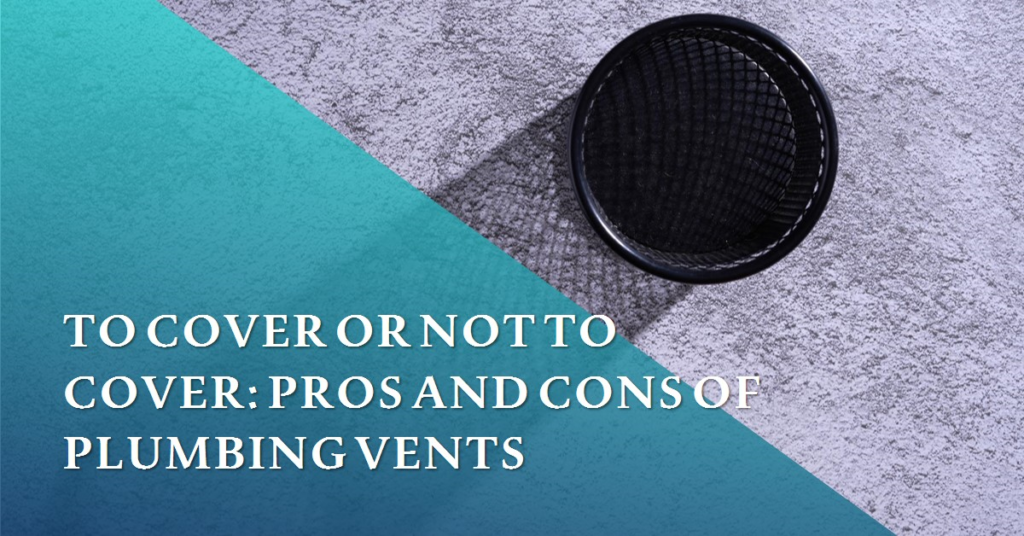
Table of Contents
- Introduction: Plumbing Vents – The Unsung Heroes of Your Home
- Understanding Plumbing Vents: What Do They Do?
- The Case for Covering Plumbing Vents: Protection from Debris
- The Case Against Covering Plumbing Vents: Ensuring Adequate Ventilation
- Types of Plumbing Vent Covers: Choosing the Right Option
- Installation and Maintenance: Best Practices
- Potential Problems with Covered Vents: What to Watch For
- Climate Considerations: Tailoring Solutions to Your Environment
- The Cost Factor: Balancing Investment and Benefits
- Conclusion: Making an Informed Decision
Introduction: Plumbing Vents – The Unsung Heroes of Your Home
Plumbing vents, often overshadowed by the more visible parts of a plumbing system, play a crucial role in maintaining the functionality and safety of your home’s plumbing. These vents, typically extending from your roof, allow air to enter the plumbing system, facilitating the smooth flow of water and waste through your pipes. Understanding their importance and whether they should be covered is essential for homeowners.
In this blog post, we will delve into the intricacies of plumbing vents, exploring their purpose, the arguments for and against covering them, and the best practices for maintaining them. By the end, you’ll have a comprehensive understanding of how to manage these critical components of your plumbing system.
Understanding Plumbing Vents: What Do They Do?
Plumbing vents, also known as vent stacks or plumbing air vents, are vertical pipes connected to your drainage system. They serve two primary functions: allowing air into the plumbing system and letting harmful gases escape.
Firstly, by letting air into the system, plumbing vents help maintain proper pressure, ensuring that water flows smoothly through the pipes. Without adequate ventilation, water can flow too slowly, leading to blockages and inefficiencies. Secondly, these vents prevent the buildup of harmful sewer gases, such as methane and hydrogen sulfide, by providing an escape route to the outside environment. This helps maintain a safe and odor-free home.
The Case for Covering Plumbing Vents: Protection from Debris
One of the primary arguments for covering plumbing vents is to protect them from debris. Open vents can become clogged with leaves, dirt, and even small animals, which can obstruct airflow and lead to plumbing issues. Covering the vents with a protective screen or cap can prevent such blockages, ensuring the vents function properly.
Moreover, in areas with frequent snowfall, uncovered vents can become blocked by ice and snow. This can cause serious problems, including backups and potential damage to the plumbing system. A well-designed vent cover can mitigate these risks by preventing snow and ice from accumulating inside the vent.
The Case Against Covering Plumbing Vents: Ensuring Adequate Ventilation
While covering plumbing vents can protect them from debris, it is crucial to ensure that any covering does not impede the airflow. Plumbing systems rely on adequate ventilation to function correctly. Improperly designed or installed covers can restrict airflow, leading to negative pressure in the system, which can cause slow drainage and sewer gas buildup inside the home.
Additionally, covering vents can sometimes cause moisture to become trapped, leading to mold and mildew growth. This can result in unpleasant odors and potential health hazards. Therefore, it is essential to choose vent covers that allow for proper ventilation while providing protection.
Types of Plumbing Vent Covers: Choosing the Right Option
Several types of plumbing vent covers are available, each designed to address specific issues. Mesh screens are a popular choice as they prevent debris from entering the vent while allowing air to flow freely. These screens are easy to install and can be a cost-effective solution for most homeowners.
Another option is vent caps, which offer more robust protection against weather elements like snow and rain. Vent caps typically have a dome or sloped design, preventing water from entering the vent while still allowing for adequate ventilation. Choosing the right type of cover depends on your specific needs and environmental conditions.
Installation and Maintenance: Best Practices
Proper installation and regular maintenance of plumbing vent covers are essential to ensure their effectiveness. When installing a vent cover, it is crucial to follow the manufacturer’s instructions carefully. This will help ensure that the cover fits securely and provides the intended protection without impeding airflow.
Regular maintenance is also vital. Periodically check the vent covers for any signs of damage or blockages. Clean the covers as needed to remove any accumulated debris. In cold climates, inspect the vents during winter to ensure they are not obstructed by ice or snow.


Potential Problems with Covered Vents: What to Watch For
Despite the benefits, covered plumbing vents can sometimes cause problems if not properly managed. One potential issue is the buildup of condensation within the vent, which can lead to rust and corrosion over time. This is particularly a concern with metal vent covers. Ensuring that the cover is well-ventilated can help mitigate this risk.
Another problem to watch for is the restriction of airflow. If the vent cover is not designed correctly, it can impede the air circulation, leading to negative pressure in the plumbing system. This can cause slow drainage and sewer gas to escape into the home, creating health hazards.
Climate Considerations: Tailoring Solutions to Your Environment
The decision to cover plumbing vents should also take into account the local climate. In regions with heavy snowfall, vent covers can prevent snow and ice blockages, ensuring the plumbing system functions smoothly during winter. Conversely, in warmer climates, the primary concern may be keeping out debris and pests, making mesh screens an effective solution.
Consider the specific environmental challenges your home faces and choose vent covers accordingly. A tailored approach will ensure that your plumbing system remains efficient and trouble-free throughout the year.
The Cost Factor: Balancing Investment and Benefits
When deciding whether to cover plumbing vents, it is essential to consider the cost. Vent covers can range from inexpensive mesh screens to more costly vent caps. While the initial investment might be higher for certain types of covers, the long-term benefits of preventing blockages and protecting your plumbing system can outweigh the costs.
Evaluate your budget and weigh the potential savings from avoiding plumbing repairs against the cost of installing vent covers. In many cases, investing in high-quality covers can be a cost-effective strategy in the long run.
Conclusion: Making an Informed Decision
Deciding whether to cover your plumbing vents requires a careful consideration of the pros and cons. Covering vents can provide significant protection against debris, snow, and pests, ensuring your plumbing system functions efficiently. However, it is crucial to choose covers that allow for adequate ventilation to avoid negative pressure and moisture buildup.
By understanding the role of plumbing vents, the types of covers available, and the best practices for installation and maintenance, you can make an informed decision that suits your home’s specific needs. Properly managed, plumbing vent covers can enhance the longevity and performance of your plumbing system, providing peace of mind and a safe, functional home environment.


